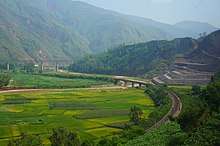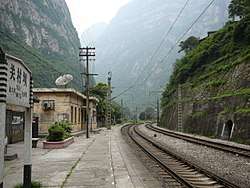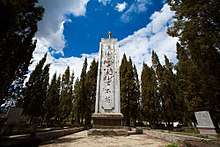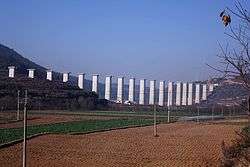Chengdu–Kunming railway
The Chengdu–Kunming railway or Chengkun railway (simplified Chinese: 成昆铁路; traditional Chinese: 成昆鐵路; pinyin: chéngkūn tiělù), is a major trunkline railroad in southwestern China between Chengdu, the capital of Sichuan Province and Kunming, the capital of Yunnan Province. The line is 1,134 km (705 mi) long and traverses rugged terrain from the Sichuan Basin to the Yunnan-Guizhou Plateau.[1] The line was built between 1958 and 1970. Major cities along route include Chengdu, Pengshan, Jiajiang, Emei, Ebian, Ganluo, Xide, Xichang, Dechang, Miyi and Panzhihua in Sichuan Province and Yuanmou, Lufeng, Anning and Kunming in Yunnan Province.
Chengdu-Kunming railway | |||||||||||||||||||||||||||||||||||||||||||||||||||||||||||||||||||||||||||||||||||||||||||||||||||||||||||||||||||||||||||||||||||||||||||||||||||||||||||||||||||||||||||||||||||||||||||||||||||||||||||||||||||||||||||||||||||||||||||||||||||||||||||||||||||||||||||||||||||||||||||||||||||||||||||||||||||||||||||||||||||||||||||||||||||||||||||||||||||||||||||||||||||||||||||||||||||||||||||||||||||||||||||||||||||||||||||||||||||||||||||||||||||||||||||||||||||||||||||||||||||||||||||||||||||||||||||||||||||||||||||||||||||||||||||||||||||||||||||||||||||||||||||||||||||||||||||||||||||||||||||||||||||||||||||||||||||||||||||||||||||||||||||||||||||||||||||||||||||||||||||||||||||||||||||||||||||||||||||||||||||||||||||||||||||||||||||||||||||||||||||||||||||||||||||||||||||||||||||||||||||||||||||||||||||||||||||||||||||||||||||||||||||||||||||||||||||||||||||||||||||||||||||||||||||||||||||||||||||||||||||||||||||||||||||||||||||||||||||||||||||||||||||||||||||||||||||||||||||||||
|---|---|---|---|---|---|---|---|---|---|---|---|---|---|---|---|---|---|---|---|---|---|---|---|---|---|---|---|---|---|---|---|---|---|---|---|---|---|---|---|---|---|---|---|---|---|---|---|---|---|---|---|---|---|---|---|---|---|---|---|---|---|---|---|---|---|---|---|---|---|---|---|---|---|---|---|---|---|---|---|---|---|---|---|---|---|---|---|---|---|---|---|---|---|---|---|---|---|---|---|---|---|---|---|---|---|---|---|---|---|---|---|---|---|---|---|---|---|---|---|---|---|---|---|---|---|---|---|---|---|---|---|---|---|---|---|---|---|---|---|---|---|---|---|---|---|---|---|---|---|---|---|---|---|---|---|---|---|---|---|---|---|---|---|---|---|---|---|---|---|---|---|---|---|---|---|---|---|---|---|---|---|---|---|---|---|---|---|---|---|---|---|---|---|---|---|---|---|---|---|---|---|---|---|---|---|---|---|---|---|---|---|---|---|---|---|---|---|---|---|---|---|---|---|---|---|---|---|---|---|---|---|---|---|---|---|---|---|---|---|---|---|---|---|---|---|---|---|---|---|---|---|---|---|---|---|---|---|---|---|---|---|---|---|---|---|---|---|---|---|---|---|---|---|---|---|---|---|---|---|---|---|---|---|---|---|---|---|---|---|---|---|---|---|---|---|---|---|---|---|---|---|---|---|---|---|---|---|---|---|---|---|---|---|---|---|---|---|---|---|---|---|---|---|---|---|---|---|---|---|---|---|---|---|---|---|---|---|---|---|---|---|---|---|---|---|---|---|---|---|---|---|---|---|---|---|---|---|---|---|---|---|---|---|---|---|---|---|---|---|---|---|---|---|---|---|---|---|---|---|---|---|---|---|---|---|---|---|---|---|---|---|---|---|---|---|---|---|---|---|---|---|---|---|---|---|---|---|---|---|---|---|---|---|---|---|---|---|---|---|---|---|---|---|---|---|---|---|---|---|---|---|---|---|---|---|---|---|---|---|---|---|---|---|---|---|---|---|---|---|---|---|---|---|---|---|---|---|---|---|---|---|---|---|---|---|---|---|---|---|---|---|---|---|---|---|---|---|---|---|---|---|---|---|---|---|---|---|---|---|---|---|---|---|---|---|---|---|---|---|---|---|---|---|---|---|---|---|---|---|---|---|---|---|---|---|---|---|---|---|---|---|---|---|---|---|---|---|---|---|---|---|---|---|---|---|---|---|---|---|---|---|---|---|---|---|---|---|---|---|---|---|---|---|---|---|---|---|---|---|---|---|---|---|---|---|---|---|---|---|---|---|---|---|---|---|---|---|---|---|---|---|---|---|---|---|---|---|---|---|---|---|---|---|---|---|---|---|---|---|---|---|---|---|---|---|---|---|---|---|---|---|---|---|---|---|---|---|---|---|---|---|---|---|---|---|---|---|---|---|---|---|---|---|---|---|---|---|---|---|---|---|---|---|---|---|---|---|---|---|---|---|---|---|---|---|---|---|---|---|---|---|---|---|---|---|---|---|---|---|---|---|---|---|---|---|---|---|---|---|---|---|---|---|---|---|---|---|---|---|---|---|---|---|---|---|---|---|---|---|---|---|---|---|---|---|---|---|---|---|---|---|---|---|---|---|---|---|---|---|---|---|---|---|---|---|---|---|---|---|---|---|---|---|---|---|---|---|---|---|---|---|---|---|---|---|---|---|---|---|---|---|---|---|---|---|---|---|---|---|---|---|---|---|---|---|---|---|---|---|---|---|---|---|---|---|---|---|---|---|---|---|---|---|---|---|---|---|---|---|---|---|---|---|---|---|---|---|---|---|---|---|---|---|---|---|---|---|---|---|---|---|---|---|---|---|---|---|---|---|---|---|---|---|---|---|---|---|---|---|---|---|---|---|---|---|---|---|---|---|---|---|---|---|---|---|---|---|---|---|---|---|---|---|---|---|---|---|---|---|---|---|---|---|---|---|---|---|---|---|---|---|---|---|---|---|---|---|---|---|---|---|---|---|---|---|---|---|---|---|---|---|---|---|---|---|---|---|---|---|---|---|---|---|---|---|---|---|---|---|---|---|---|---|---|---|---|---|---|---|---|---|---|---|---|---|---|---|---|---|---|---|---|---|---|---|---|---|---|---|---|---|---|---|---|---|---|---|---|---|---|---|---|---|---|---|---|---|---|---|---|---|---|---|---|---|---|---|---|---|---|---|---|---|---|---|---|---|---|---|---|---|---|---|---|---|---|---|---|---|---|---|---|---|---|---|---|---|---|---|
| |||||||||||||||||||||||||||||||||||||||||||||||||||||||||||||||||||||||||||||||||||||||||||||||||||||||||||||||||||||||||||||||||||||||||||||||||||||||||||||||||||||||||||||||||||||||||||||||||||||||||||||||||||||||||||||||||||||||||||||||||||||||||||||||||||||||||||||||||||||||||||||||||||||||||||||||||||||||||||||||||||||||||||||||||||||||||||||||||||||||||||||||||||||||||||||||||||||||||||||||||||||||||||||||||||||||||||||||||||||||||||||||||||||||||||||||||||||||||||||||||||||||||||||||||||||||||||||||||||||||||||||||||||||||||||||||||||||||||||||||||||||||||||||||||||||||||||||||||||||||||||||||||||||||||||||||||||||||||||||||||||||||||||||||||||||||||||||||||||||||||||||||||||||||||||||||||||||||||||||||||||||||||||||||||||||||||||||||||||||||||||||||||||||||||||||||||||||||||||||||||||||||||||||||||||||||||||||||||||||||||||||||||||||||||||||||||||||||||||||||||||||||||||||||||||||||||||||||||||||||||||||||||||||||||||||||||||||||||||||||||||||||||||||||||||||||||||||||||||||||



History

Planning of the Chengdu–Kunming railway began in 1952 with several routes under consideration.[1] The western-most route over the most difficult terrain was selected in 1956. Construction began in 1958 during the Great Leap Forward and expanded to full-scale in 1964. In July 1970, the line was completed and entered into operation in January 1971.[1] The government published a pictorial in 1976 showing pictures of the construction and extreme terrain that required hundreds of tunnels and bridges. [2] Building conditions were hazardous and 2,100 workers perished during the construction of the original line.[3] On August 30, 2000, the entire line was electrified.[1] Aside from Chengdu and Kunming, the line has a total of 122 stations.[1][4]
Sculpture
.jpg)
In 1974, an ivory sculpture commemorating the completion of the Chengdu–Kunming railway was presented as a gift to the United Nations and is displayed at the U.N. Headquarters in New York.[5] The sculpture depicts the rail bridge across the Dadu River between two mountain peaks, with intricate details of passengers inside the train.[6] The sculpture, 150 cm in length and 110 cm in height, was made from eight elephant tusks and weighs over 300 kilograms.[5]
Railway junctions
The Chengkun railway is a major trunkline in China's railway network and connects with numerous other railway lines including:[4]
Sichuan Province
Yunnan Province
- Guangtong: Guangtong–Dali railway
- Kunming: Shanghai–Kunming railway, Nanning–Kunming railway, Kunming–Yuxi railway
Natural Disaster Vulnerability
Four sections of the railroad which pass through the Niuri River Valley, Manshuiwan to Xichang of the Anning River Valley, Jinsha River Valley and Longchuan River Valley are under the exposure of the vulnerable debris flow and landslide. Soviet experts used to make a prediction that the railroad "will be turned into a pile of scrap iron by violent nature even after it is completed" in the route design stage;[7] An Imagery Analysis Service Note published by CIA in October 1971 made a statement that "[the railraod] will undoubtedly require more than the normal maintenance because of the rugged terrain it passes through" based on the detected at least two replacement works of the destroyed tracks caused by landslides in the first year of its operation.[8]
Upon operation, major natural disasters were not occurred in the Anning River Valley and Longchuan River Valley section due to the thoughtful route selection and complete protection strategies adopted. However, the Niuri River Valley had a faster flow of the river - due to the short in length, steep channel, and unstable valley side slope - did not catch enough concerns in the construction period. Multiple incidents of debris flow have occurred in the Niuri River Valley section especially between Niri – Suxiong and Lianghong – Aidai.[9]
See also
- Daliang Mountains
- List of railways in China
- 1981 Chengdu–Kunming rail crash
References
- 《中国铁路线》 P25-26 Last Accessed 2011-07-31
- "Mountains and Rivers Make Way: The Chengtu-Kunming Railroad in Photographs," published by the Foreign Languages Press (Peking: 1976).
- (Chinese) "成昆铁路:生命铺就的英雄史诗" Archived May 23, 2011, at the Wayback Machine Last Accessed 2011-07-31
- Quail Map Company (2008). China railway Atlas (third ed.). Quail Map Company. ISBN 978-1-898319-82-5.
- "Chinese Ivory Carving" UN.org Archived August 24, 2011, at the Wayback Machine Last Accessed 2011-07-31
- "China Presents Ivory Carving to United Nations" Last Accessed 2011-07-31
- "成昆铁路40年 与灾害正面交锋的40年". 云南网 昆明铁道报 (in Chinese). 新浪网. 2010-07-13.
- "Construction of Cheng-tu/Kun-ming Rail Line was a Major Engineering Accomplishment" (PDF). Imagery Analysis Service Note. CIA. 1971-10-08. p. 2 – via Freedom of Information Act Electronic Reading Room.
.
- 严壁玉; 王茂靖 (2005). "穿越"地质博物馆"的成昆铁路". 铁道工程学报 (in Chinese). doi:10.3969/j.issn.1006-2106.2005.z1.027.
External links

- Documentary on the construction of the Chengkun railway